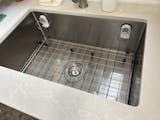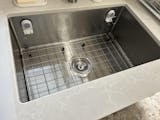Choosing the Ideal Farmhouse Sink and What To Expect

To start things off, what is a farmhouse sink?
In Australia, a farmhouse sink is often referred to as an apron sink or a belfast sink. This type of sink has gained popularity in both traditional and contemporary kitchen designs and is usually a large single bowl that is spacious and deep. The hallmark of a farmhouse sink is its prominent apron-front section, which protrudes beyond the benchtop and cabinetry, resulting in a distinctive and stylish look. Typically, farmhouse sinks are constructed from materials such as fine fireclay, porcelain, stainless steel, or copper. While they frequently feature a large single bowl, some models are designed with double bowls as well. Farmhouse sinks are celebrated for their practicality, durability, and aesthetic appeal. Offering ample room for washing large pots, pans, and various kitchen utensils, these sinks are highly favoured by home chefs and families alike in Australia and all over the world.

Types of Farmhouse Sink
Farmhouse sinks come in various materials and there isn't a single "best" material for it, as the ideal choice depends on your preferences, budget, and desired aesthetics. However, here are some of the most popular materials for farmhouse sinks, each with its own advantages and drawbacks:
- Fireclay: Fireclay sinks are created by blending clay and glaze, which are then subjected to high temperatures, resulting in a durable and non-porous surface. This process reinforces both the ceramic clay and porcelain enamel and imparts a sleek, glossy sheen to the sink. Fireclay farmhouse sinks are available in a diverse range of colours and unique ribbed/fluted patterns on the front apron since the enamel is applied separately. Furthermore, single and double bowl fireclay sinks are readily available. Due to their scratch, stain, and heat-resistant nature, these sinks are a popular choice for their classic appearance and low maintenance. However, it is important to note that fine fireclay farmhouse sinks are typically heavy and may require additional support from surrounding cabinetry. As a result, it is recommended to plan for installation early in your kitchen design process.
- Stainless steel: Stainless steel farmhouse sinks are particularly popular for their sleek appearance, durability, and affordability. These sinks are resistant to heat, stains, and rust, making them easy to clean and maintain. However, they are prone to displaying water spots, and like all stainless steel products, they are susceptible to scratching. A brushed or satin finish can help mask wear and tear more effectively than a mirror or chrome-like finish. Despite this, they require relatively little maintenance. Stainless steel also makes for an excellent choice when coordinating with stainless steel appliances as well as tapware.
- Porcelain: Porcelain farmhouse sinks are typically made from cast iron or steel that is coated with a layer of porcelain enamel, resulting in a classic gloss white and timeless appearance. Maintaining the pristine look of a classic gloss white porcelain farmhouse sink will need regular cleaning. While they are resistant to stains and heat, heavy items dropped onto the surface can result in chipping or cracking - especially if you frequently use heavy cookware, such as cast-iron pans. Careful washing of dishes and using a protective sink mat can prevent the chances of damaging the sink.
- Copper: For a striking design statement in your kitchen, consider a copper farmhouse sink to add a unique and warm rustic aesthetic. Copper is naturally resistant to stains, rust, and bacteria, making it an excellent choice for maintaining sanitary conditions with minimal effort. However, copper sinks can be costly and require more maintenance than other materials as they develop a patina over time and may need periodic polishing to maintain their appearance. It is essential to be cautious when cleaning your copper apron front sink, using only mild soap and water or a specialty copper cleaner. Additionally, avoid contact with hot pots and pans and acidic substances. Despite careful handling, copper will likely darken over time due to the patina development.
-
Granite composite: Granite sinks composite farmhouse sinks are among the toughest farmhouse sink options available, offering exceptional resistance to scratches and stains. Made from a blend of natural granite and acrylic resin, granite composite sinks provide a contemporary look and excellent durability. They are heat-resistant, stain-resistant, and scratch-resistant but can be heavy, requiring additional support during installation. It is crucial to handle granite composite farmhouse sinks with care during delivery and installation to prevent cracking. Fortunately, granite composite is a sturdy material that can resist heat and fading, and it doesn't require the use of harsh chemicals to clean it.
- Natural stone: Stone farmhouse sinks are known for their high-end look, but they also come with a high price tag. Some stone materials are also prone to staining, so it's important to get a sample first and test it out personally. You may need to reseal it at least every year or two to maintain the appearance and prolong the life of your stone farmhouse sink. Additionally, keep in mind that different stone materials will behave differently and will have different maintenance requirements.
- Cast iron: Cast iron farmhouse sinks are a great option for a rustic kitchen design, as they offer a classic and traditional look. The enamel finish of cast iron sinks is incredibly durable and resistant to scratches and rusting. However, because of the weight of the sink, it may require additional support during installation, which will impact the design of your kitchen. Also, if the enamel is chipped and the bare iron is exposed, it can rust quickly, so care should be taken to prevent damage to the sink.

Size, Configuration, and Installation
When it comes to choosing a size for your farmhouse sink, it's important to consider your kitchen layout and design style. While there is no standard size, most farmhouse style sinks fall within certain ranges to accommodate different needs. The width of farmhouse sinks typically varies between 610 and 914 millimetres. However, you may find smaller or larger options to suit your specific needs. The depth of farmhouse sinks usually ranges from 450 to 600 millimetres. This measurement is essential to ensure the sink fits comfortably within your kitchen's cabinetry and benchtop layout. The height of farmhouse sinks, which is the distance from the top edge to the bottom, can vary depending on the design and the depth of the basin. Most farmhouse sinks have a height between 200 and 250 millimetres, although deeper options with a height of up to 300 millimetres are also available for those who require additional basin capacity. Keep in mind that the size of your farmhouse sink should be compatible with your kitchen's layout, cabinetry, and benchtop design. Before making a purchase, measure the available space and consult with a professional to ensure proper installation and compatibility with your existing kitchen components.

The choice between a large single bowl and double bowl farmhouse sink also depends on the size of your kitchen or laundry and the amount of bench space you have available. A single bowl sink can be an ideal choice for a smaller kitchen or laundry where counter space is at a premium, as it provides more space for washing dishes, preparing food or light handwashing. In contrast, a double bowl sink may be a better option for larger kitchens with more bench space, where the added convenience of having two separate bowls can be advantageous. It's also important to consider your cooking and cleaning habits when choosing between a single or double bowl sink. If you frequently cook and entertain, a double bowl sink may be more practical since you can use one bowl for washing dishes and the other for food prep. If you prefer a minimalist design and prioritize easy cleaning, a single bowl sink may be a better option since it doesn't have a divider that can collect debris.
Another consideration is the material of the sink. Certain materials, such as fine fireclay, cast iron, and copper, may be better suited for a single bowl sink due to their weight and size. These materials can be more challenging to work with in a double bowl sink since the weight can put additional strain on the benchtop.
Additionally, the installation method of the kitchen or laundry sink should also be considered when choosing the size and style. Farmhouse sinks can be installed in two ways: as an undermount or as a top-mount sink. An undermount sink is mounted underneath the benchtop and is a popular choice for those who want a seamless, clean look. This installation method requires specific measurements and installation techniques to ensure a secure and stable sink. A top-mount sink, on the other hand, is installed by dropping the sink into the benchtop cut out. Because a farmhouse sink has no lip to hold the sink up, the cabinet maker would have to build a cabinet with a substrate to hold the sink up.

Farmhouse Sink vs. Standard Kitchen Sink
Farmhouse sinks and standard kitchen sinks differ in several aspects, including design, installation, and aesthetics. The most noticeable difference between a farmhouse sink and a standard kitchen sink is the design. Farmhouse sinks feature a distinctive exposed front section that extends beyond the benchtop and cabinets. In contrast, standard kitchen sinks have a more conventional design, with the basin sitting within the benchtop and the front edge concealed by the cabinetry. Farmhouse sinks usually require custom cabinetry or modifications to existing cabinets to accommodate their unique design and size. They are typically installed as an undermount or a top-mount sink, with the front apron fully visible. Standard kitchen sinks, on the other hand, are either undermount or top-mount and do not require specialized cabinetry. In terms of functionality, farmhouse sinks are generally deeper and wider than standard kitchen sinks. Additionally, the apron front design of farmhouse sinks can help reduce strain on your back and arms since you don't have to lean over as far to reach the sink basin. Aesthetic appeal is another area where farmhouse sinks stand out. Their unique, eye-catching design can add character and charm to your kitchen, making them a popular choice among Australians looking to create a warm, inviting space. Standard kitchen sinks in comparison offer a more conventional and versatile look, which can blend well with various kitchen or laundry styles.
That being said, there are some drawbacks to farmhouse sinks as well. They are quite limited to a single or double bowl and will not have drainers attached. Whereas standard kitchen sinks come in a wider range of sizes and configurations, including single bowl, double bowl, tap landing sinks, and those with drainer options. Farmhouse sinks also tend to be more expensive than standard kitchen sinks due to their larger size and unique design. The protruding front panel of farmhouse sinks can also make them more difficult to install and may require professional assistance. Finally, the size and weight of farmhouse sinks can make them less compatible with certain benchtop materials, which can limit your options when it comes to selecting a sink.

Benchtops for Farmhouse Sinks
- Natural stone: Granite or marble benchtops are compatible with farmhouse sinks and can create a stunning and luxurious look in your kitchen. It offers unique patterns and colours, as well as durability and heat resistance. However, marble and some types of granite are porous which means it will require sealing to protect them from stains and moisture. Regular sealing around the sink area is essential to maintain the stone's appearance and durability. Proper installation and support are crucial to prevent damage to both the sink and the benchtop over time. If you are willing to invest in the care and upkeep of a natural stone benchtop, it can definitely create an elegant and timeless aesthetic in your kitchen.
- Engineered stone: Engineered stone benchtops are made from a combination of natural stone particles (usually quartz) and resin. The non-porous nature of composite stone means it doesn't require sealing and is easy to clean, making it a practical choice for use with farmhouse sinks. These are available in a wide range of colours, patterns, and finishes, allowing you to find the perfect match for your farmhouse sink and overall kitchen design. Because of the nature of the material, it can be fabricated with various edge profiles to complement the style of your farmhouse sink and create a seamless look.
- Wood: Pairing a wooden benchtop with a farmhouse sink can create a warm, rustic, and inviting atmosphere in your kitchen, but it requires careful installation and regular maintenance to prevent water damage and maintain its appearance. Wooden benchtops require sealing and oiling to protect them from water and moisture damage. This is particularly important around the sink area, where water exposure is more frequent. It's crucial to ensure that the area around the sink, including cutouts and joints, is properly sealed to prevent water from seeping into the wood and causing damage. Choose a wood species known for its moisture resistance and are less prone to warping and water damage - making them better suited for use around a farmhouse sink.
- Laminate benchtop: Laminate benchtops can be compatible with farmhouse sinks, but there are certain precautions and considerations to keep in mind. It is made from layers of high-density fibreboard or particleboard bonded with a decorative layer and a protective surface. They are affordable, low-maintenance, and available in a wide range of styles and colours. However, they are more susceptible to water damage than other materials, so it's crucial to ensure the area around the sink is well-sealed. Laminate benchtops also have limitations when it comes to edge profiles and customization. This may restrict the design options you have when pairing it with a farmhouse sink.
Before finalising your benchtop material choice for a farmhouse sink, it is essential to check the warranty provided by your supplier. This is especially important when considering laminate benchtops. While laminate is an affordable and versatile option, it may not be as durable as other materials when it comes to water resistance and heat resistance. The warranty provided by the supplier can give you an idea of the material's expected lifespan and any limitations. Benchtop suppliers may have different warranty terms, so it's important to compare your options and choose a benchtop material and supplier that offers the best combination of quality, durability, and warranty coverage. Additionally, working with a professional installer who has experience with farmhouse sinks can help ensure proper installation and support, reducing the risk of potential issues down the line.
Cabinetry Considerations
A farmhouse sink requires specific cabinetry configurations to accommodate its unique design and weight. The first requirement will be the cut out or notched front of the base cabinet to accommodate the apron-front design of the sink. The base cabinet must be specifically designed or modified for a farmhouse sink, taking into account the size and weight of the sink. Farmhouse sinks generally require a larger and deeper base cabinet compared to standard undermount or top-mount sinks. Be sure to consult the sink manufacturer's specifications for the required cabinet dimensions. Because of that weight (especially if they are made from materials like fireclay or cast iron), your base cabinet should be reinforced to support the additional weight. This reinforcement might include additional bracing, support beams, or a support frame at the bottom of the cabinet. The cabinet doors and drawers below the sink should be designed to fit around the apron-front, which may require custom-sized doors, false drawer fronts, or other modifications. The farmhouse sink should be aligned with adjacent cabinetry and appliances, considering factors such as cabinet heights, the height of the sink's apron-front, and any additional trim or decorative elements.
It's essential to consult with a professional kitchen designer or cabinet maker who has experience working with farmhouse sinks to ensure proper installation and support. They can help you plan and modify your cabinetry configuration to accommodate the unique requirements of a farmhouse sink, ensuring a seamless and functional result.

Farmhouse Sinks in Different Kitchen Styles
While farmhouse sinks are traditionally linked to rustic, country, or farmhouse style kitchens, it has now evolved over time and effortlessly adapted to a wide range of kitchen designs. Their versatility and functionality make them a popular choice for Australians seeking to add a unique touch to their kitchen or laundry spaces.
Porcelain farmhouse sinks, with their smooth, gloss white finish, can elevate the aesthetic of a contemporary kitchen. The timeless elegance of porcelain, combined with the practicality of a large, deep basin, creates a beautiful focal point in any kitchen or laundry. If you are looking to make a bold statement in an industrial-style space, a concrete farmhouse sink is an excellent choice. In a modern or contemporary kitchen, a sleek stainless steel farmhouse sink offers an updated twist on the classic apron-front design. High quality stainless steel is not only durable and easy to maintain, but it also complements contemporary kitchen elements like stainless steel appliances and modern cabinetry. The streamlined appearance of a stainless steel sink lends itself well to minimalist and uncluttered kitchen designs.
Farmhouse sinks have transcended their country roots and are now a versatile design element in various kitchen designs. These sinks provide not only practical benefits but also serve as a striking design feature that can enhance the overall look and feel of your kitchen. The growing popularity and aesthetic allure of farmhouse sinks make them a valuable addition to any home. Their distinctive style and practicality can catch the eye of potential buyers, who may see them as a highly sought-after feature in Australian homes. By incorporating a farmhouse sink into your kitchen design, you not only enhance the space's visual appeal but may also contribute to increasing your home's overall value, making it an attractive investment for those who appreciate the unique blend of style and function it offers.
Many Australians are drawn to the charm of a farmhouse sink but hesitate due to the traditional models' inability to cushion the impact of dropped glassware, resulting in a higher likelihood of breakage.
Buildmat's reimagined classic farmhouse sink: Boden Belfast Farmhouse Sink
Buildmat's Boden Belfast Farmhouse Sink is a modern rendition available in both stainless steel and brushed gunmetal, allowing you to select the perfect option that complements your design preferences. Explore our high-quality Boden Belfast Farmhouse Sink today and enjoy the perfect fusion of style and functionality without compromising on practicality!














